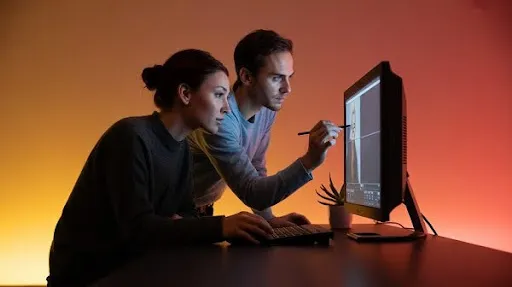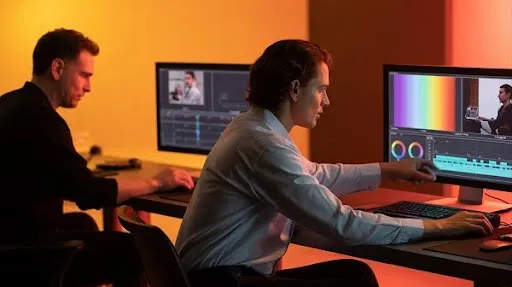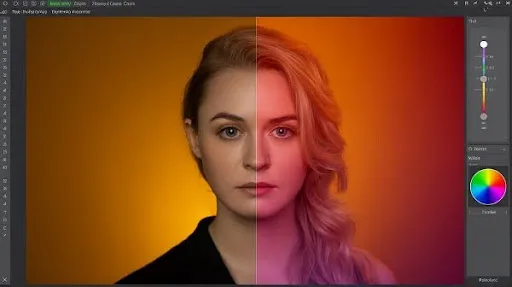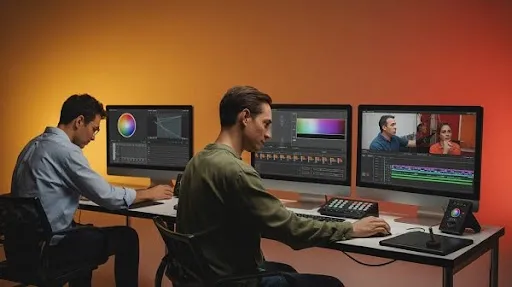Scroll through YouTube, Instagram, or Netflix, and something jumps out quick. Certain videos feel polished without screaming “edited.” Skin looks healthy, shadows still have detail, and nothing feels oddly tinted. The secret usually isn’t the camera; it’s color correction.
This step isn’t only a bandage for mistakes. Correction is what makes raw footage feel real, smooths out awkward lighting, and builds the foundation for creative adjustments like color grading. If your clips look dull, mismatched, or tinted, correction is what pulls them back on track.
In this guide, we’ll unpack what is color correction, why it comes before grading, the benefits of color correction, and the tools editors trust for professional-looking results.
What Is Color Correction?
At its simplest, color correction is the process of adjusting the colors in video footage so it matches what your eyes expect to see. Cameras don’t see like people do. The lens, the sensor, the lighting, each bends colors in a way that often looks “off.”
Some classic examples:
- Fluorescent office lighting gives everything a green cast.
- A table lamp indoors makes faces look orange.
- Cloudy daylight can turn skin flat and gray.
Correction fixes these issues by dialing in four key areas:
- White balance: Whites should look neutral, not tinted blue or yellow.
- Exposure: Brightness is leveled so details aren’t lost in shadows or blown out.
- Contrast: Dark and light areas are balanced to add depth without crushing details.
- Color balance: Fine-tuning red, green, and blue so tones look natural again.
Once corrected, the footage mirrors real-life colors. Just as important, it gives editors a clean slate for stylizing colors later through grading.
Color Correction vs. Color Grading
These two steps are constantly mixed up. They aren’t interchangeable.
- Color correction: Think of this as the cleanup stage. It fixes exposure, balances tones, and restores natural color.
- Color grading: This is where creativity kicks in. Editors use color grading tools to craft a mood, golden warmth for nostalgia, cool blues for tension, and muted tones for grit.
The order matters. If you grade first, you’re layering style on top of distorted color. That rarely works. Correct first. Grade after. You can also get in touch with a 3D animation studio to get the best color correction services.
Why Editors Rely on Color Correction
Skipping correction isn’t a shortcut; it’s a mistake that shows. Here’s why it matters so much:
Consistency Across Shots
Footage shot in different places will never match perfectly. Different bulbs, different daylight angles, different shadows. Balancing colors across clips ties everything together so the story flows.
Cleaner, More Appealing Footage
Uncorrected video often looks flat or lifeless. Simple fixes in exposure, contrast, and color balance bring back vibrancy without pushing things into neon territory.
Balanced Exposure
Dark shadows hide detail. Overexposed skies lose definition. Correction evens things out so every part of the frame stays usable.
Smooth Flow for Long Projects
In a 30-second ad, mismatched colors are annoying. In a documentary or series, they’re unbearable. Correction keeps long-form content cohesive.
A Base for Creativity
Advanced color grading only works on a solid foundation. Correction lays that base. Skipping it makes grading sloppy and inconsistent.
How Color Correction Works
Editors rely on tools like DaVinci Resolve, Adobe Premiere Pro, or Final Cut Pro. Each platform has unique strengths, but the correction workflow is fairly universal.
Fixing White Balance
This is step one, always. Whites that look blue or yellow ruin a scene instantly. Correcting this immediately improves skin tones and surfaces.
Adjusting Exposure
Too dark? Lift it. Too bright? Pull it back. Exposure tweaks bring footage into a usable range.
Refining Contrast
Flat footage feels boring. Heavy contrast kills details. The sweet spot adds depth while keeping texture visible.
Balancing Colors
Every frame is built on red, green, and blue. If one overpowers the others, like green indoors, you adjust until the tones look neutral.
It’s not a one-click fix. Editors make small changes, step back, and adjust again until the shot feels right.
Fact: A study in 2024 (published in the Sensors journal) revealed that incorporating perceptual color attributes—such as brightness, saturation, and contrast—enhanced the precision of forecasting subtle emotions in video clips, surpassing the results obtained by solely utilizing objective features.
Best Practices for Effective Correction
Done carelessly, correction can cause more harm than good. A few rules help:
- Start with white balance. Get this wrong and every other adjustment feels wrong.
- Use scopes and histograms. Monitors can mislead, but scopes give accurate data.
- Stay consistent across clips. Don’t treat each one as its own island.
- Begin with decent footage. Correction won’t save poorly lit or noisy video.
- Don’t overdo it. Oversaturation or extreme contrast looks fake. Natural tones win every time.
Common Mistakes in Color Correction
Even experienced editors trip up here. Some of the most common errors include:
- Whites that stay tinted after “fixing.”
- Inconsistent corrections between clips.
- Heavy saturation that makes the footage cartoonish.
- Trusting only the monitor and ignoring the scopes.
These mistakes build quickly. The fix? Patience. Small, subtle corrections go further than big swings.
What Color Correction Can and Can’t Do
What It Fixes
- Lighting differences between clips.
- Restores real-life colors.
- Creates continuity across a project.
- Prepares footage for stylizing colors later.
What It Can’t Fix
- Footage shot too dark or too bright, details lost can’t be recovered.
- Low resolution. Correction won’t turn 720p into 4K.
- Poor framing or lighting mistakes during filming.
Correction enhances, but it’s not a miracle worker. Strong source material is still essential.
Why Consistency Holds It All Together
Imagine watching an interview: one angle looks warm, the next has a green tint, and the wide shot feels flat. Even if the dialogue is amazing, the color mismatch distracts you.
That’s why correction is non-negotiable. Balancing colors keeps viewers focused on the content, not the flaws.
Tools for Color Correction
The most popular platforms are:
- DaVinci Resolve: Known for precision and advanced color grading. A favorite in film.
- Adobe Premiere Pro: Flexible and works well with After Effects. Great for most creators.
- Final Cut Pro: Optimized for Macs. Less advanced than Resolve but excellent for correction work.
All three provide detailed control over exposure, white balance, and color balance. They take practice, but once you know the workflow, they’re reliable for professional results.
How Color Correction Inspires Creativity
Correction alone won’t make footage cinematic, but it creates the groundwork. Once the clips are corrected, editors can stylize colors with grading, warmth, cool tones, desaturated grit, whatever the mood calls for. Without correction, grading falls flat.
Advanced Techniques in Color Correction
Getting the basics right, white balance, contrast, and exposure, will carry you far. But sooner or later, you’ll hit a ceiling. That’s when advanced correction techniques come in. These aren’t about fixing mistakes; they’re about giving your footage polish that separates “just okay” from professional.
Secondary Color Correction
Think of primary correction as repainting the whole wall. Secondary correction is pulling out a tiny brush to touch up details. You might brighten just the subject’s face without touching the background. Or maybe you want the sky a touch bluer while keeping skin tones realistic.
This kind of precision is what professional color correction services lean on when a brand wants one element to “pop” without the rest looking artificial.
Noise and Highlight Recovery
Noisy night shots, blown-out windows, every editor has seen them. While correction can’t turn garbage into gold, the right tools (Resolve is excellent here) can smooth out noise and pull back just enough highlight detail to save a shot. It’s like dusting off an old photo: you can’t erase the years, but you can make it viewable again.
Matching Across Cameras
Multi-cam shoots are both a blessing and a curse. Different cameras mean different sensors, different “flavors” of color. One angle leans warm, the other leans cold, and suddenly your interview looks stitched together. Correction brings them back into harmony, so the edit flows instead of jolting viewers out of the moment.
Why Color Correction Shapes the Story
Correction isn’t just a technical checkbox; it directly changes how people feel while watching.
- Emotional consistency
Imagine a tearful scene where one shot feels cool and the next overly warm. Viewers might not know why it feels wrong, but they’ll sense it. Color correction keeps emotions uninterrupted.
- Professional credibility
Good correction hides in plain sight. Bad correction jumps out instantly and screams “amateur.”
- Support for branding
Brands live on consistency. A fitness ad with crisp whites and clean skin tones says something very different from a cozy café ad with golden hues. Correction is what makes those brand promises believable.
That’s why talking about color correction in video editing is really talking about storytelling, because mismatched visuals break trust just as fast as a sloppy script.
A Workflow the Pros Stick To
If you ever wonder how editors keep projects consistent, it’s because they follow a tight workflow. While every project has quirks, a common approach looks like this:
- Organize and sync first – sort footage, line up audio, trim the junk.
- Base corrections – exposure, white balance, contrast. The essentials.
- Match shots across the cut – otherwise, you’ll notice one camera angle drifting off.
- Secondary refinements – tweaking skin tones, isolating skies, evening out odd patches.
- Scope check – waveform and vectorscope don’t lie. Your monitor might.
This step-by-step keeps corrections clean, especially in bigger projects where “eyeballing it” will burn you later.
What Color Correction Really Delivers
Here’s where the benefits of color correction shine through:
- Saves projects from mismatched lighting – morning, noon, and night clips can finally sit side by side.
- Elevates brand image – polished visuals say, “we care about quality.”
- Keeps viewers watching – people bounce off videos that feel “off,” even if they don’t know why.
- Makes grading easier – once corrected, you’re free to go wild with style.
Correction doesn’t just “fix.” It future-proofs the edit.
Frequently Asked Questions
Is color correction the same as grading?
No. Correction gets your footage accurate and natural. Grading adds the “look” or mood on top.
Can it save really bad footage?
Sometimes, but don’t expect miracles. If a shot is blown out or too noisy, correction can only do so much.
Do I need expensive gear?
Not at all. Resolve is free and ridiculously powerful. Paid tools just speed up workflow if you’re working at scale.
Why are skin tones such a big deal?
Because viewers notice instantly if they look wrong. We’re wired to pick up on it. Nail the skin, and you’ve nailed half the job.
Should I learn correction before grading?
Absolutely. Skipping correction is like painting over a dirty wall. Get the base right first.
Final Words
Correction doesn’t grab the spotlight, but without it, the show falls apart. It’s what turns scattered, uneven clips into something cohesive and watchable. More importantly, it’s the base that lets your creative grading actually shine.
Whether you’re a freelancer tightening up a client’s promo or a brand manager outsourcing professional color correction services, from one of the best animation companies in Dallas, the message is the same: don’t skip this step. Correct first, grade later, and your videos will hold attention for all the right reasons.
Related Articles:











